The Launch Pad 39 Complex located on Merritt Island in Florida, is a very unique historical site. The complex was originally contemplated to have five pads, 2,700 m apart from each other as a precaution in case of explosion. From the five launch pads originally planned, only two were built: Launch Pad 39A and 39B. With a total of 92 launches from 1967 to 2011, Launch Pad39A was used to launch all Saturn V rockets to the moon during the Apollo era –with the exception of Apollo 10, which lifted off from launch pad 39B – the Saturn 1Bs to the Skylab space station, and several missions of the Space Shuttle.
The design of the launch pads took into account measures to ensure the safety of workers and crews. Despite the popularity of the site, not many people know about the existence of the network of safety tunnels and bunkers lying approximately 12 meters below the launch pads. As a matter of fact, access has always been restricted, and over the time only a few selected people have had the privilege of visiting them. The bunkers were designed as an emergency escape system for crews and workers during the Apollo era in case of a failure that could end in an explosion on the launch pad.
From the Fire to the Safety of the Rubber Room
Before every mission, crews were trained in emergency egress procedures from the capsule or the orbiter, followed by a rapid descent from the top of the orbiter inside a special elevator that could take them to the base of the mobile launch platform (MLP) in less than 30 seconds. On the base of the MLP they would then open a door that led to a 61 meter flat rubber deceleration slide that delivered them into the so-called rubber room. The name comes from the fact that the walls are tapered with rubber covered cushions to absorb the blast. After arriving to the rubber room, the procedure required the crew to open a 6 inch steel door connected to the blast room, which is mounted on a series of springs that can absorb the violent vibrations of an explosion, thereby preserving the area. Aligned around this room there are 20 fixed chairs, each one big enough to sit an astronaut with a full pressure suit, equipped with safety belts. The room has fire blankets, a toilet, a chart on the wall with vital information and enough carbon dioxide filters to keep up to 20 people alive for 24 hours. After the danger was overcome, the crew needed to cross a long tunnel to egress in a place 366 meters away from the pad.
Both launch pad 39A and 39B have their own rubber and blast rooms, even though the ones under launch pad 39B were closed for safety concerns related to lead paint. Luckily, these rooms were never used as there have been no rocket explosions on the launch pad. With the end of the Apollo era and the beginning of the Shuttle missions, another emergency egress method was conceived, consisting of a slide wire taking crews 763m away from the launch pad to take shelter in bunkers.
On the west side of the launch pad 39A there is the Environmental Control Systems Room (ECS), where the clean air that was fed into the Mobile Launch Platform and Space Shuttle was produced. It contained electrical lines and uninterruptible power systems as well.
Many communication and instrumentation lines are placed underground to connect the control area with the assembly areas and with the launch pads. For the Space Shuttle launch operations a new Fixed Service Structure (FSS) was built in the launch pad, a Rotating Service Structure (RSS) was placed on site, and the Saturn flame deflectors were replaced. The Rotating Service Structure provided safe access to the Shuttle for installation and servicing of some systems, as well as easy access to installed payloads.
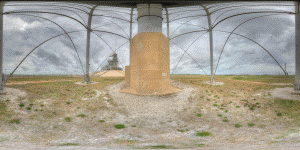
At the SSS vertical main feed line thrust block. Click for immersive panoramic view (Credits: NASA Tech).
Beneath the pad, there are also areas called “Catacombs,” where Sound Suppression water is pumped to different places around the pad immediately before the main engine ignition. This system was designed to protect the shuttle and payloads from being damaged by the sound energy reflected during the launch.
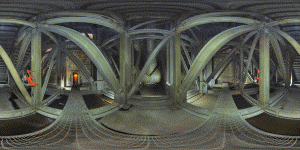
Under the flame deflector in the flame trench. Click for immersive panoramic view (Credits: NASA Tech).
The flame deflector structure is covered with a high-temperature concrete material 13 cm thick and extends across the center of the flame trench. These system deflected the flames from the orbiter main engines and the solid rocket boosters. As recounted in NASA Tech, the launch pad 39A experienced major damage during the launch of Shuttle Discovery mission STS-124 in 2008. The concrete trench used to deflect the SRB´s flames were damage as a result of carbonation of epoxy and corrosion of steel anchors.
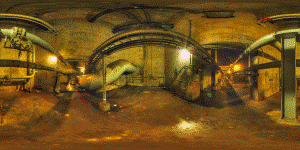
In the west underpad utility area by a sound suppression feed line. Click for an immersive panoramic view (Credits: NASA Tech).
The glorious history of Launch Pad 39A is not yet over: on December 13, 2013, NASA awarded SpaceX a twenty year exclusive contract to use the Launch Pad 39A for future launches of Falcon 9 and Falcon Heavy.





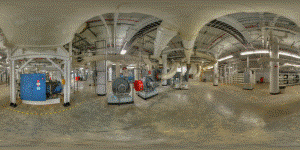
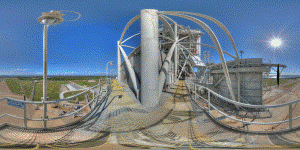
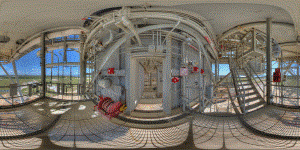
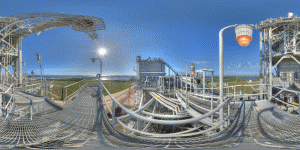
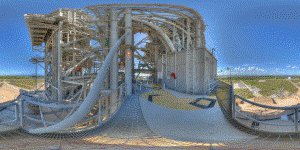







































![A trajectory analysis that used a computational fluid dynamics approach to determine the likely position and velocity histories of the foam (Credits: NASA Ref [1] p61).](https://www.spacesafetymagazine.com/wp-content/uploads/2014/05/fluid-dynamics-trajectory-analysis-50x50.jpg)



Carmen this is excellent work I was in a school nea
r the cape in the early 70s and we did get a special tour of this launch pad although we did not go into the tunnels but I new about these emergency procedures, and by the way I live in monterrey mexico